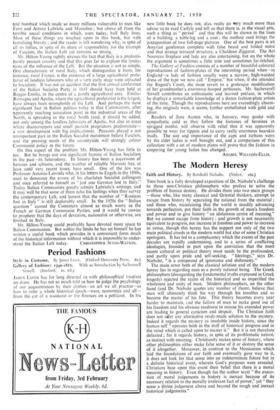Socialists in Italy
THIS book appears opportunely at a moment when recent events have once again brought the Italian Left into prominence and shown up both its strength and its weakness. Agrarian disturbances in the South during the autumn have reminded those whom the electoral victory of the Christian Democrats in April, 1948, may have lulled into complacency that the Communist challenge is still formidable ; while the failure of the negotiations for Socialist reunion and the emergence in December of a third fully-fledged Socialist Party have shown that bitter disputes over tactics, personal jealousies and a tendency to disintegration, of which this book records so many past examples, still flourish in the Italian Socialist movement.
Mr. Hilton-Young has collected a mass of information which has hitherto been unobtainable in English and often difficult to find even in Italian. Out of it he has made a readable narrative, enlivened by shrewd pen portraits of leading personalities and valuable summaries of rival Socialist tendencies and programmes. He traces the story of Italian Socialism and Communism from their earliest origins in the 1860s down to their electoral defeat in 1948. But the Italian Left cannot be studied in a vacuum, without relation to the conflicting political and social forces which conditioned it. Mr. Hilton-Young has, of course, realised this ; but his attempts to sketch in the general background leave much to be desired and may easily mislead those unfamiliar with modern Italian history. Italian Socialism has drawn its strength from many sources: from a strong tradition of intellectual sinistrismo or leftism, soaked in anti-clericalism ; from the capacity for selfless devotion to the cause of the downtrodden, sometimes compared to that cif the followers of St. Francis, which distinguished such early Socialist leaders as Bissolati and Prampolini, and which can be found in the Communist Party today from that fatal.Italian weakness for oratmy
and bombast which made so many millions vulnerable to men like Ferri and Arturo Labriola and Mussolini ; but above all from the terrible social conditions in which, even today, half Italy lives. Most of these things are touched upon in this book, but with tantalising brevity ; and the reader is left wondering why, in spite of all its follies, in spite of its share of responsibility for the triumph of Fascism, the Italian Left yet remains so strong.
Mr. Hilton-Young rightly stresses the fact that Italy is a predomi- nantly peasant country and that this goes far to explain the limita- tions of the influence of the Left. But the situation is not so simple.
One characteristic of rural Italy, which distinguishes it from, for instance, rural France, is the existence of a large agricultural prole- tariat of landless labourers who at a very early stage were attracted
to Socialism. It was not an accident that the first annual conference of the Italian Socialist Party in 1893 should have been held at
Reggio Emilia, in the centre of a purely agricultural area. Emilia- Romagna and Apulia, where the agricultural proletariat is the largest, have always been strongholds of the Left. And perhaps the most significant fact in Italian politics today is that Communism, after apparently reaching saturation point in the industrial areas of the North, is spreading in the rural South (and, it should be added, not only among the landless labourers of Apulia, but also in areas where sharecroppers and small peasant proprietors predominate— a new development with big implications). Peasants played a not unimportant part in the Italian Socialist movement before Fascism, and the pressing needs of the countryside will strongly colour Communist policy in the future.
On this aspect of the problem Mr. Hilton-Young has little to say. But he brings out one significant feature of Italian Socialism in the past—its heterodoxy. Its history has been a succession of heresies and schisms, and the number of reliable Marxists has, at least until very recent times, been small. One of the few was Professor Antonio Labriola who, in his letters to Engels in the 1890s, used to denounce the errors of his charlatan Socialist colleagues and once referred to himself as "just one German lost in Italy."
Today Italian Communists greatly admire Labriola's writings, and It may well be that some of them echo his feelings when they survey the contemporary Left, and lament that the number of "Russians lost in Italy" is still deplorably small. In the 1920s the "Italian question" caused the Comintern almost as much worry as the French or German Communist Parties, and it would be unwise to prophesy that the days of deviation, nationalist or otherwise, are finished in Italy.
Mr. Hilton-Young could profitably have devoted more space to Italian Communism. tut within the limits he has set himself he has written a useful book which provides in a convenient form much of the historical information without which it is impossible to under-











































 Previous page
Previous page